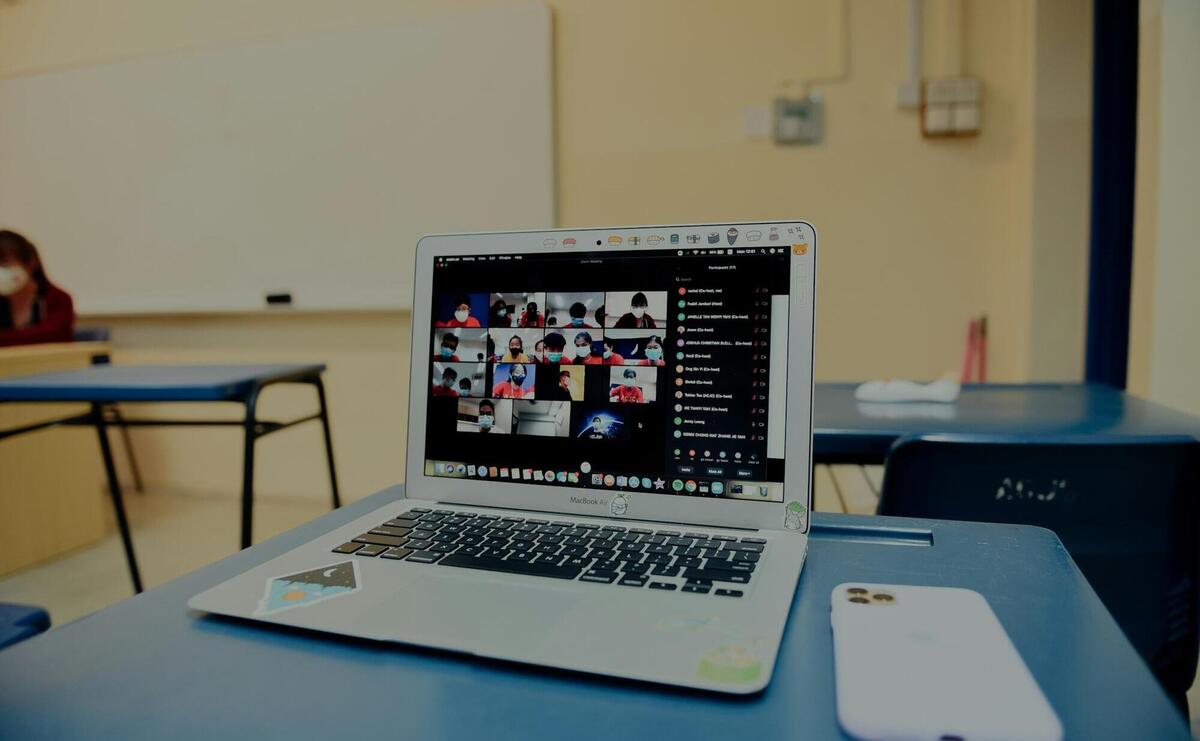Hybrid Class Meaning, Benefits & Implementation Tips

There is more than one way for students to receive their education from their teachers. The traditional way is in person, where all students are gathered in a classroom, and the teacher teaches in-person sessions.
Virtual learning implies receiving education online, mostly from the comfort of the student's home, while listening to their teacher over digital platforms as tools such as Zoom or Google Meet.
However, there is a way of teaching that combines both of these approaches, and that is called hybrid learning. In hybrid classes, students will receive part of their education in person and part of it through virtual classes.
With this model becoming more and more popular around the world, this article aims to research the purpose of hybrid learning, its benefits, and ways to implement it successfully.
Short Summary
- Hybrid learning combines in-person learning and online learning to maximize benefits for students in hybrid classrooms.
- Hybrid classes require students to use technology to attend online discussions and lessons and complete a certain number of in-person classes.
- A hybrid class tries to respond to the challenges of face-to-face learning by offering modern, interactive solutions, making it a problem-based learning approach as well.
Definition of Hybrid Class
The best and easiest way to understand hybrid classes is to think of them as a combination of in-person learning in the classroom and online learning.
With hybrid classes, students are able to study from a classroom and from their own homes, using digital solutions to connect with the rest of the class.
Unlike fully online courses, hybrid classes require students to attend in-person sessions on campus to a certain percentage.
The reason hybrid courses are gaining more popularity is that they offer flexibility and mixed learning, which benefits diverse learners.
A hybrid course model blends different online learning formats, ensuring that students receive both asynchronous and synchronous lessons. In a hybrid class, expect discussions, quizzes, peer reviews, and so on.
Hybrid classes combine both of these approaches to maximize the benefits for students and for teachers as well. Gaining more flexibility has also proven to lead to a higher success rate for both sides.
Main Benefits of Hybrid Classes

Hybrid classrooms provide the best of both worlds in many aspects. In addition to participating in in-person lectures with their teachers and fellow students, students can do their schoolwork online. However, there are more benefits to it than just flexibility.
1. Diverse Learning And Personalization
Hybrid classes give you greater control over your education, and you may choose from various learning methods and preferences. You are free to interact with the course materials and whatever you learn best. Course slides can be reviewed frequently if you're a visual learner, and lectures can be viewed again if you're an auditory learner.
2. Great Introduction to Online Classes
More and more college students are completing their degrees via online courses from ITIL certification to project management classes. An ideal way to introduce students to remote learning is through a hybrid course. With the comfort of in-person classes, students learn how to use distance learning technology, communicate with instructors, and manage their schoolwork.
3. Increased Accessibility
For certain people, an in-person learning approach might provide challenges. With these blended courses, students may focus on one less thing while managing work and childcare. In addition to making it more straightforward to squeeze in doctor's visits, students who choose not to commute to campus during snowstorms or other bad weather also avoid having to drive on hazardous roadways.
Downsides of Hybrid Learning
Although there are numerous benefits of taking a hybrid course, one must also be aware of its potential downsides. As it is with any learning approach, some students will benefit from hybrid courses and some will not.
Find below a few potential disadvantages of hybrid courses that you'll need to be aware of if you or your child is a part of a hybrid class.
1. Less Engagement
In contrast to in-person learning, hybrid learning restricts your ability to communicate with your teacher and fellow students in real time. If you are a social butterfly who finds it difficult to relate to peers and your teacher, you can eventually lose interest in a hybrid course and might benefit more from in-person learning.
2. Time Management
Hybrid learning necessitates self-control and effective time management. Completing online assignments alone might be difficult if you struggle with time management. Passiveness and procrastination are two behaviors that can cause overload and cause you to fall behind on your duties when taking hybrid courses.
3. Technology Requirements
Hybrid courses typically include tech prerequisites, such as a computer that satisfies the college's criteria and dependable internet connectivity. Some students may need to upgrade their current equipment or purchase a new computer to enroll in a hybrid course. Depending on the curriculum, students taking a hybrid course can also need to buy software.
Implementing a Hybrid Class

A hybrid class format requires a lot of online instruction, well-prepared course materials, and engaging in-person class management to support diverse learners in their goal to succeed academically.
However, organizing and managing online classes with diverse groups of students is not an easy job.
Unlike face-to-face instruction, teachers will need to look for different techniques to check if active learning is being applied by their students.
For teachers who are looking to form online classes for their students, these are the tips to live by:
- Be aware of each student's learning preferences and their own pace of learning, and offer them options throughout the hybrid learning course.
- When teaching in person, make sure you leave time to address any concerns, questions, or doubts you or your students might have regarding online components.
- When planning online activities for a hybrid format, think of the different ways to start a class discussion among your remote students to improve engagement.
- Aim that all of your interactions with parents are either through emails or in-person meetings to avoid confusion and to give them maximum attention.
- Motivate students to work together through collaborative work and gather feedback from them frequently.
- Prepare well before each online class and define learning outcomes for each person and online lesson.
- Seek ways to respond to challenges of remote learning, such as low social activity and lack of concentration.
Conclusion
There are many differences between face-to-face classes and hybrid courses. However, if you are taking such a course, there are other factors to consider and ensure you have access to additional support if needed.
For each student, the experience of being in a hybrid class can be different. Some will benefit from blended learning, while others will struggle to keep up with the course due to poor time management or organizational skills.
The great thing about such an online environment is that students can enjoy these dynamic classes and different online learning activities, but they also need to pay extra attention to online instruction if they want to achieve success.
Whether you're a teacher looking to implement these courses or a student who is considering enrolling in classes with online interactions, you will need to be aware of the pros and cons of such a hybrid instruction approach.
Frequently Asked Questions
What Are Examples of Hybrid Courses?
Hybrid courses can best be explained as a class or a program that combines face-to-face time in the classroom and online learning. Throughout the course, teachers provide online work and in-class activities for their students. Students need digital solutions for their remote learning, but also to facilitate online discussions with their peers and teachers.
What Is the Difference Between a Hybrid Class And an Online Class?
In hybrid courses, the course content is being taught both online and in face-to-face interactions with students on campus. In an online class, there is no face-to-face interaction, and the entire class time is spent in the physical classrooms with the teacher and students. Courses that combine blended learning still have elements of traditional learning while also bringing the potential of digital solutions into education. A fully online course will offer all of its content online, and in most cases, students don't even meet their teachers and many colleges.
Is Hybrid Teaching Effective?
There are many factors that will determine whether remote learning is better than face-to-face learning for a student. Not everyone learns the same way, so a hybrid course might be a better solution for someone, and others might notice that they are falling behind. However, both a teacher and a student will need to be aware of how the nature of the course is affecting their learning objectives, and if hybrid instruction is not as effective as expected, the student should consider in-person instruction instead. There is no wrong option, after all, as the only goal is that students complete their courses successfully and work towards their educational objectives.